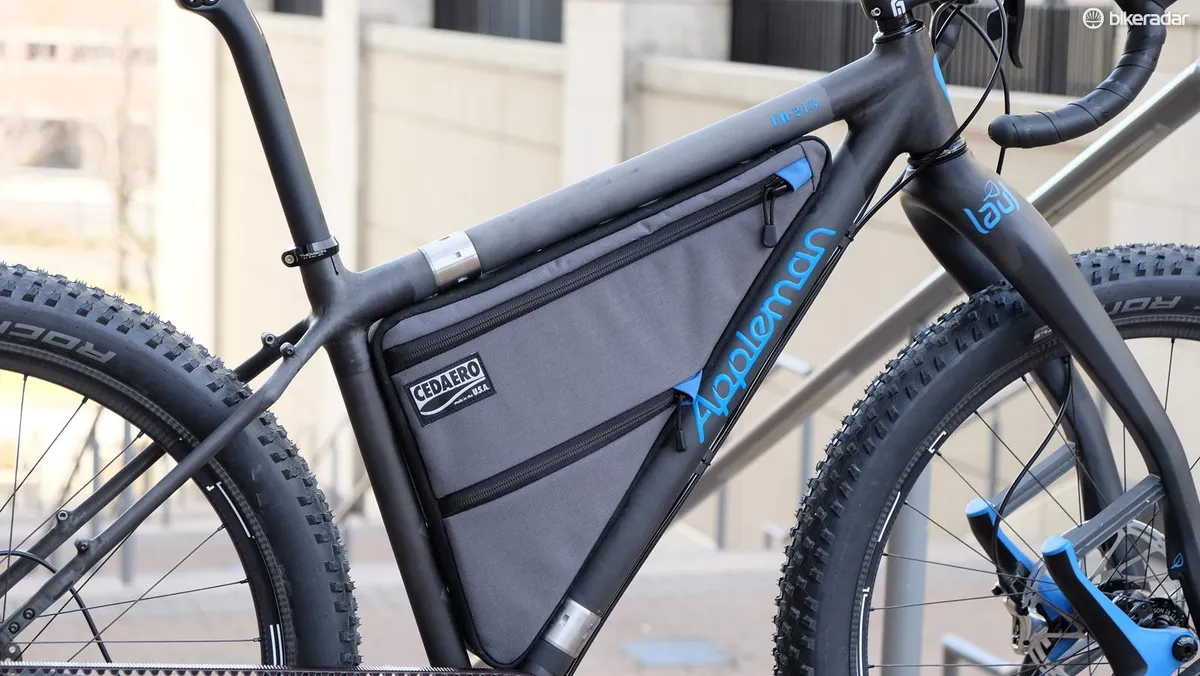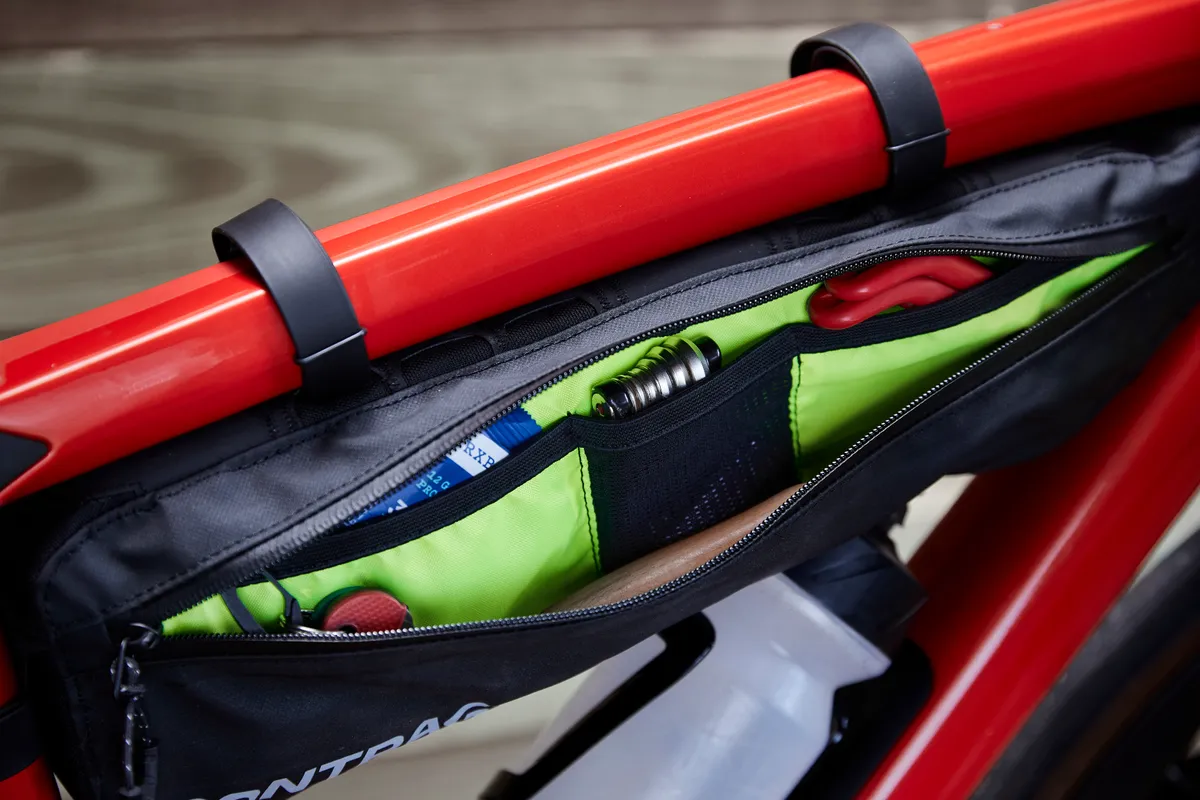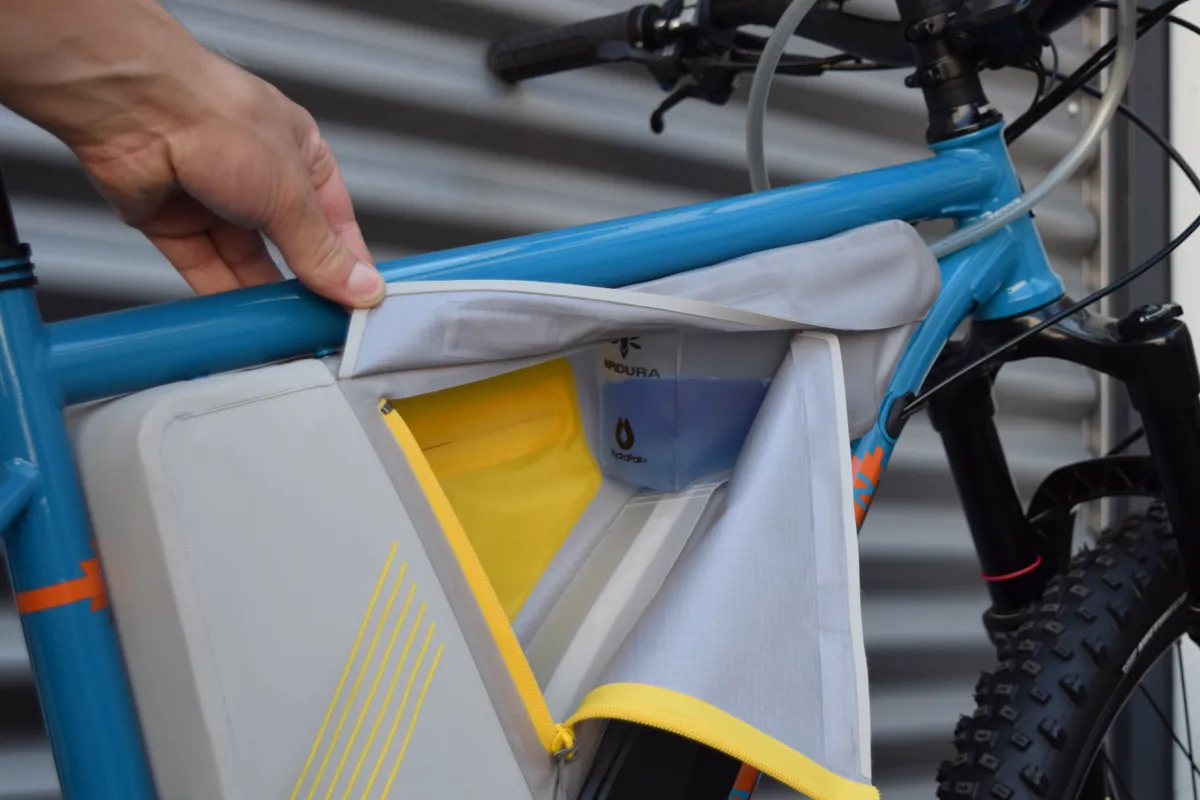A frame bag is a good way to add luggage capacity to your bike in a low-profile bikepacking bag that helps distribute weight across the bike.
When paired with an extended bikepacking saddle bag and a handlebar bag, you’re getting almost as much stowage space as a set of small panniers.
A frame bag is the perfect place to stow less bulky items for accessibility, without impeding your pedalling.
Here, we’ll look at the types of bike frame bag you can buy, why they're useful and how to choose a frame bag to meet your needs.
Frame bag types

Frame bags vary from small wedges designed to carry a few extra items on a ride to bags that completely fill the space within your bike’s front triangle.
You may choose to run a frame bag in addition to a bag that sits above your top tube to add even more capacity.
Consider how much stuff you want to carry as a first step, because this will help you choose which type is best for you. We’ll run through the options.
Full-frame bag

A full-frame bag will almost completely fill the space within your frame triangle and provide the largest capacity of the types available.
It will have multiple attachment points to all three frame members to keep it stable and in position. Most bags use webbing to attach. Some bags and bikes feature braze-ons, enabling you to bolt a bag directly to the bike.
Clearly, this design will prevent you from mounting bottle cages inside the frame triangle, so you need to adopt another method to carry fluids. We discuss this in more detail below.
Half-frame bag

A half-frame bag is suspended from your top tube, usually with additional straps that attach to your down tube and seat tube to help hold it in place.
While some have the same depth along their length, some newer designs add a little extra capacity with a deeper section at the front, which follows the line of your down tube before tapering upwards.
Depending on your frame dimensions, you may be able to fit one or two water bottles within the triangle, so this design makes water carrying easier, at the expense of bag capacity.
Wedge bags

A wedge bag fills the space between your top tube, head tube and down tube at the front of your bike, without extending all the way back to your seat tube.
As with a half-frame bag, this lowers its capacity, but helps with bottle mounting and keeps the bag out of the way of your legs. It’s a good option for a few extras, both on shorter rides and to augment the capacity of other bikepacking bags you may be using.
Again, the standard method to fit the bag in place is Velcro straps. However, the new Canyon Grail has a wedge bag available that attaches to its frame using Fidlock magnetic clips.
You can also find frame wedge bags that are designed to sit between your seat tube and the rear of your top tube, if you prefer that positioning.
How to select a frame bag
There are a few essential features you need to consider when choosing the best bicycle frame bag for your needs, which we’ll discuss here. Additional design features may help you fine-tune the details and draw up a shortlist. We’ll discuss those in the next section.
Fit with your frame

Fit inside your frame triangle is essential, particularly with a full-frame bag.
It’s also going to be a decider in the length of half-frame bag you can mount, although it’s less critical with a wedge bag.
Manufacturers will typically offer multiple bag sizes for their full-frame and half-frame bags, usually at least three, to fit different-sized frames. Although the straps provide some leeway, make sure you choose a bag that will fit inside your frame and will mount securely. Brands will provide detailed dimensions for their bags, so you can make sure your chosen size will fit.
If you can’t find a bag that will fit your frame, Restrap, for example, will make you a bespoke bag to your required dimensions and specification. Many other small-scale manufacturers offer similar services.
Capacity

The size of bike frame bag you can fit will clearly affect its capacity. Apidura’s Expedition full-frame pack, for example, is available in four sizes that can hold between six and 14 litres; Restrap’s three sizes vary in capacity between six and nine litres.
Think about what you want to carry and decide whether you want a full-frame bag or a smaller design. Blackburn makes a bag that can be expanded from a half-frame to a full-frame design if you don’t always need its full capacity.
Width
The width of a frame bag will be limited by the need to be able to pedal comfortably. Manufacturers will have thought of this and made their bags slim enough to fit, but make sure you’re going to be comfortable with a bag fixed between your legs. Sometimes, a bag will have stiffened sides, to help stop it from bulging, although soft-sided bags are also sold.
What to look for in a bike frame bag
Once you’ve made a shortlist of frame bags that will meet your needs, there are a range of other design features that may help you to choose between them, which we’ll run through next.
Fixing system

The standard method used to fix a frame bag in your bike’s triangle is wide Velcro straps. Some bags may use paracord or elasticated cords. There will typically be two or three to mount the frame bag to your top tube, plus further straps on the down tube and on the seat tube.
It’s the seat tube where adjustment to fit your frame is usually made, so straps here may be longer than elsewhere.
Rubbing against your frame is likely to occur, so add frame protection under the straps. Some straps are rubberised, which helps to prevent movement of the straps and the bag as you ride and to avoid damage to the frame.
Fabric
The space within your frame triangle has the potential for significant rubbing, both against your frame tubing, and your legs and shoes, as you pedal.
A frame bag needs to be made of robust fabric to withstand this. Ideally, it should include reinforced areas around the frame mounting points as well.
You can usually expect some reflective details to help increase your visibility.
Internal organisation

Most frame bags will include some form of internal compartmentation. This is handy because the deep and narrow form means stuff would otherwise sink to the bottom, potentially causing sagging. Sometimes there’s an internal sleeve pocket, which can be useful to hold thinner items.
You also want to be able to find stuff easily without rummaging through the bag or needing to empty its contents, particularly since it’s a good place to stash items such as food, waterproof clothing or a repair kit that you might need during your ride. You may be able to buy additional internal bags to help with organisation.
Some bags will have multiple zips to make it easier to get at stuff packed lower down. A frame bag may have a cable port, so you can use a power pack to keep your GPS and other devices alive, or route a drinking tube from an internal bladder.
You may also get an external sleeve pocket on the side of the bag.
Weatherproofing

Bikepacking bags are made to withstand riding in poor weather, so you can expect waterproof fabric and zips – and sometimes storm flaps – to keep water out. Welded or taped seams will help avoid water ingress, but even so it’s wise to use waterproof dry bags inside to keep delicate items dry.
Water-bottle compatibility

An important constraint on the type of frame bag you might choose is its ability to work with your water-carrying needs. Any frame bag is going to impede access to water bottles to a greater or lesser extent.
That’s dependent on your frame size as well as that of the frame bag; a larger frame might enable you to still use one or two water bottles mounted inside the frame triangle with a half-frame or wedge bag. If you ride a smaller frame or one with compact geometry, you might need to forego in-frame water storage though, even with a smaller frame-bag design.
Fortunately, many gravel bikes have a third bottle mount under the down tube, which you could press into use, although you’re probably not going to want to drink from the bottle’s nozzle.
Other options to carry fluids include fixing a bottle cage to the top tube or fork legs if you have the necessary mounts, or using a reservoir inside your handlebar bag.
Some frame bags have the option to add a bladder too. Apidura sells bladders with 1.5 or 3l capacity, which typically sit in the bottom of its frame bags, for example.
